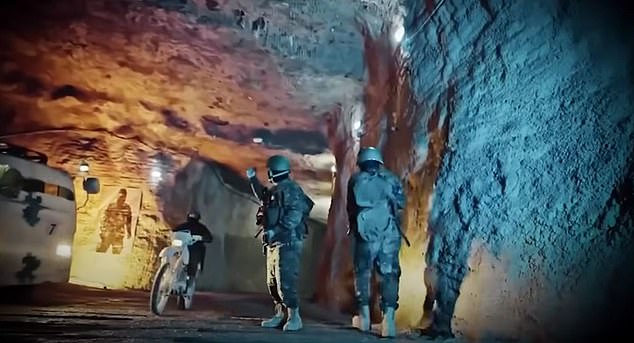At first glance, the scene has an almost rudimentary and amateurish feel. The rock is hard and jagged. Marks and scratches from heavy excavation equipment dot the walls.
They almost look like caves, but they are Hezbollah’s “tunnels of terror” and, like the group itself, they are sophisticated, powerful and deadly. One year after the atrocities of October 7, it is clear that murder comes to Israel not only from the air but from what lies beneath.
Last week, the IDF revealed that even before troops crossed the border into Lebanon on October 1, Israeli special forces had carried out dozens of operations in the south of the country to destroy Hezbollah tunnels. The threat posed by Hamas tunnels is better known and much of the work in Gaza in recent months has involved trying to remove them. Now Israel is trying to confront an even greater threat to its north.
At a press conference on Tuesday, Rear Admiral Daniel Hagari reported that after attacking a Hezbollah compound, Israeli troops had discovered a map that was to be used by terrorists during an invasion of northern Israel called Operation Conquer Galilee.
“As you can see, it has a legend marking the Israeli settlements,” Hagari said, bringing the map closer to the camera. ‘IDF posts, access roads and attack targets that Hezbollah planned to conquer.
One year after the atrocities of October 7, it is clear that murder comes to Israel not only from the air but from what lies beneath. (Israeli forces photographed inside Hezbollah tunnels)
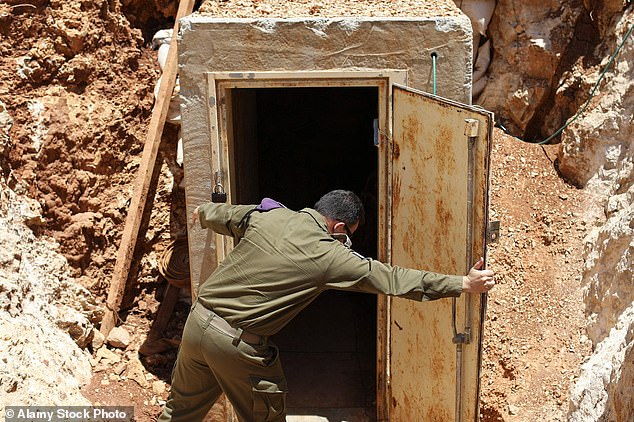
An Israeli army soldier holds the entrance door to a tunnel dug by the Lebanese Islamist political party and militant group Hezbollah.
“This map was supposed to be used by thousands of Hezbollah terrorists on the day of the order to attack the territory of the State of Israel, as Hamas did on October 7.”
Israelis are not willing to risk a second such catastrophe at the hands of Hezbollah. Yesterday, the Supreme Leader of Iran, which funds Hezbollah, called the October 7 atrocities a “justified act.”
An IDF raid took place in the village of Ayta ash Shab, southern Lebanon. Here he found dozens of underground shafts and tunnels, about 80 feet deep, with rocket launchers and ten ammunition depots. It was clear evidence of what Israeli Prime Minister Benjamin Netanyahu had told the UN in late September: that Hezbollah “secretly dug terrorist tunnels to infiltrate our communities and indiscriminately fired thousands of rockets into our cities and towns.” . An enormous amount of time, money and sweat has been invested in building this terrifying network on Israel’s northern border.
In 2021, the Alma Research and Education Center estimated that Hezbollah’s tunnels extend for “hundreds of kilometers” and, like those of Hamas, “contain underground command and control rooms, weapons depots and supplies, field clinics, and specific designated wells used to fire missiles.” of all kinds’.
Alma assessed its length as “significantly larger” than even the network running through Gaza: the so-called “Hamas subway,” which is estimated to be longer than the London Underground.
The IDF estimates that before the war, the Hamas network stretched for at least 186 miles with a depth of between 50 and 200 feet, with an average tunnel more than 6 feet high and 3 feet wide. In 2020, the IDF found a 230-foot-deep tunnel.
Its cost was also enormous. In August 2014, the Israeli army destroyed 32 Hamas tunnels estimated to have cost $90m (£69m) to build.
The average tunnel required 350 truckloads of construction materials, enough to build 86 houses.
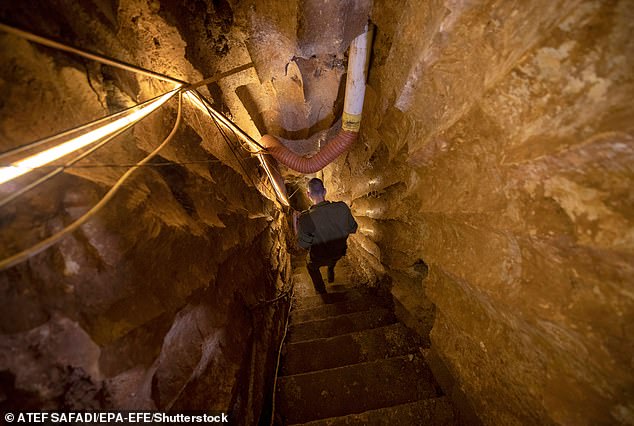
Israeli special forces carried out dozens of operations in the south of the country to destroy Hezbollah tunnels. (An Israeli soldier in a tunnel dug by the Lebanese militant group Hezbollah)
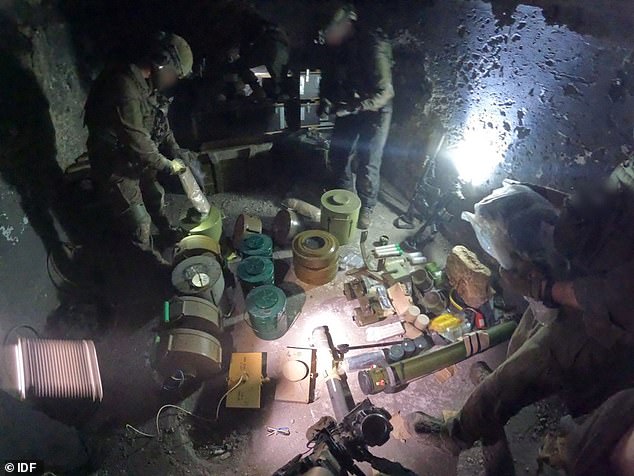
Israeli special forces have carried out more than 70 operations in southern Lebanon and have spent hundreds of days and more than 200 nights in Lebanon over the past year.
Hamas began experimenting with tunnels into Egypt in the late 1990s, while Hezbollah only adopted the tactic after its 2006 war with Israel. The two groups have spent years exchanging information and sharing techniques around tunnel warfare.
According to Dr Daphne Richemond-Barak, professor at Israel’s Reichman University and author of Underground Warfare: ‘There is electricity and ventilation. Some contain bedrooms, with mattresses, refrigerators and kitchens. There are also military bases with all the necessary equipment. Everything is geared toward being able to stay underground for long periods.
“I have no doubt that the ground invasion of Lebanon right now is related to the tunnels.”
Tunnels link even major cities. It may be beyond the IDF’s power to destroy the entire network, but at least the tunnels in the south of the country must be dealt with.
It will be a long process. In Gaza, IDF tunnel cleaners faced a number of obstacles, including Hamas booby traps. It is dangerous work, but Israel needs to understand how its enemy is making use of this increasingly strategic form of warfare.
Israel has attempted to tackle Hezbollah’s tunnel network before. In December 2018, the IDF launched Operation Northern Shield to destroy tunnels used in cross-border attacks into Israel.
In late January 2019, after finding six tunnels, IDF spokesman Jonathan Conricus said: “according to our intelligence and our assessment of the situation, there are no longer cross-border attack tunnels from Lebanon into Israel.”
If Conricus’s words smacked of arrogance, the scope and sophistication of the tunnel network destroyed back then was inescapably clear. The IDF discovered an 80-meter-deep tunnel (equivalent to a 22-story building) near the city of Zarit in northern Israel.
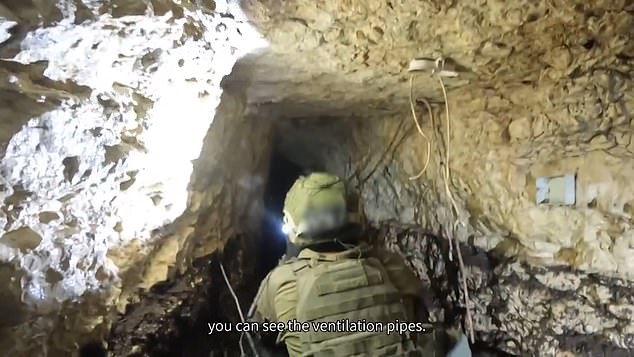
Documentation of a Hezbollah underground tunnel as IDF troops entered Ayta Ash Shab, southern Lebanon.
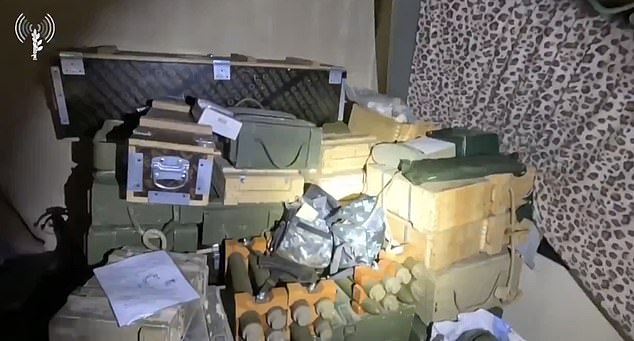
Tunnels link even major cities. It may be beyond the IDF’s power to destroy the entire network, but at least the tunnels in the south of the country must be dealt with. (The inside of a Hezbollah tunnel)
Another, which began in the village of Ramyeh, was 55 meters deep and ran 800 meters through Lebanese territory until reaching “dozens” of meters inside Israel. The tunnel had “a rail system and a passageway that allowed the movement of military equipment.”
What makes all of this more chilling is that Hezbollah’s tunnel network was built with help from North Korea. According to Richemond-Barak: ‘The Hezbollah tunnels are built to be mass invasion tunnels and are reminiscent of what North Korea planned to do to South Korea. We have evidence that the North Koreans met with Hezbollah… and the results are clear.’ Alma says the tunnels were also built with the help of Iranian companies, including those with ties to Iran’s Revolutionary Guard Corps (IRGC).
In a video released by Hezbollah in August, the walls of the tunnel are dotted with posters of Iran’s former Quds Force commander Qasem Soleimani (killed by the Americans in a drone strike in January 2020), as well as Hezbollah Secretary General Hassan Nasrallah (killed last month). in Beirut by Israeli planes).
The Iranian regime itself is the master of the underground world. It has long experience in deep underground construction: in particular to hide its nuclear facilities. Hezbollah has learned from Tehran. It is building bigger and deeper tunnels and hiding its most strategic assets within them, just as the Iranians do.
There is something about the underworld, terrorists and rogue states.
ISIS leader Abu Bakr al-Baghdadi was cornered and killed in a tunnel; Saddam Hussein was found hiding in one; and Osama bin Laden evaded American capture many times by using tunnels.
And, of course, the Israelis killed Nasrallah when he was deep in his bunker (it is likely that the last thing he saw before he died was Benjamin Netanyahu’s speech at the UN).
Nasrallah was 65 feet below Beirut and that did not save him. The F-15s used 2,000-pound Joint Direct Attack Munitions (JDAM) that penetrate deeply into their targets before exploding. Israeli military sources tell me that the air force used several of these bunker-buster bombs, one after another, to make their way so far into the ground.
The assassination of Nasrallah was not just a tactical masterstroke, it was a message to Iran: no matter how deep you or your allies hide, we will catch you.
After Nasrallah’s death, Iranians knew they had to respond. They decided to launch around 180 ballistic missiles against Tel Aviv and central Israel. Fortunately, the attack largely failed. The only death was that of a Palestinian in the West Bank, which is unequivocally tragic, but is a far cry from the mass casualties that Iran wanted.
When Iran launched these attacks, it made its move on the geopolitical board.
Now it is Israel’s turn.

